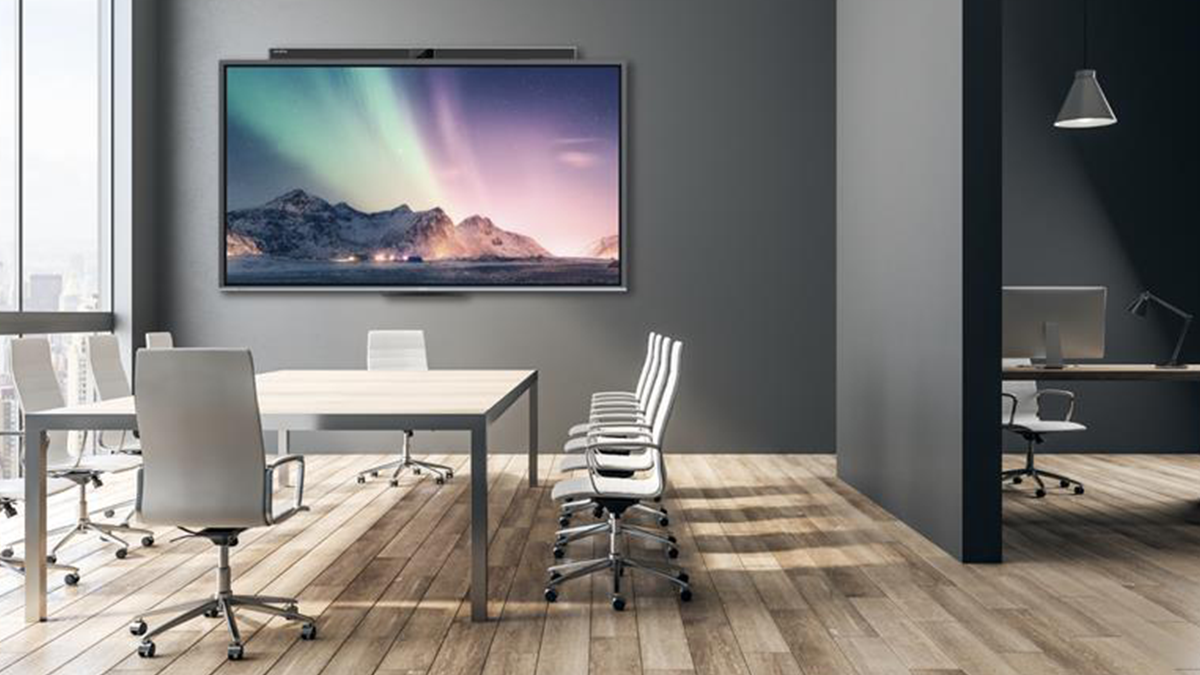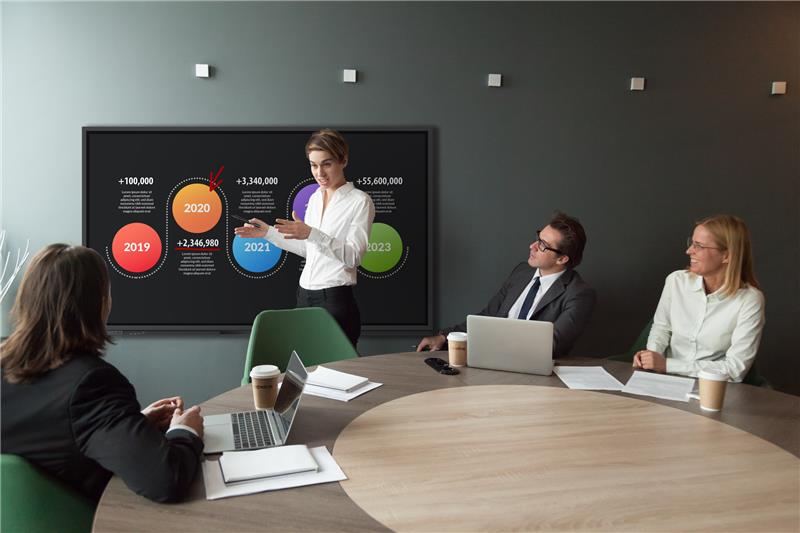
LFD and IFP displays make it possible, thanks to technological advances in panel construction and the development of increasingly advanced software, to display images in an effective and engaging manner and to interact with users. The use of an LFD display therefore entails several advantages, which we will now analyse:
LCD technology with LED/OLED backlighting
Modern LFDs exploit the well-established LCD technology with LED backlighting, i.e. based on light-emitting diodes that generate light when a current is passed through them. LED technology has practically replaced neon fluorescent lamp (CCFL) lighting, as it allows for thinner and lighter displays of the same size, with better contrast and lower power consumption. Over time, large panel manufacturers have developed alternative technologies, such as OLED and QLED, which do not require any additional components to be illuminated and allow for a wider colour gamut and excellent contrast with low latency, but with the disadvantage of a significantly higher cost.
Wide choice of formats
Installation flexibility
24-hour operation
Brightness for indoor/outdoor use
These displays are capable of transmitting clear images in all lighting conditions, adapting to the environment in which they are to be used.
For outdoor use, they must guarantee excellent readability even in bright light, and therefore their brightness should be in the range of 2,300 to 2,700 cd/m², while indoor models 'suffice' between 300 and 700 cd/m² (Nit).
Versatility of control and management
Functionally, LFDs are similar to professional PC desktop monitors. Simply connect a computer, media player or external USB stick to enjoy the desired content immediately. In some models, the player is integrated and can be controlled via a network thanks to management software. Specific apps are also available for the Android and iOS worlds with which the display can be remotely controlled via tablet or smartphone, or even apps (such as Chimpa RDM) with which documents and applications can be remotely controlled, serviced and sent to several interactive monitors at the same time, or certain functions can be restricted.
Interactivity
An interactive monitor is the centrepiece of a modern meeting room: thanks to the touch screen that characterises IFPs (Interactive Flat Panels), the devices provide a much more immediate and productive mode of operation. They often have Android embedded on board, which increases their versatility. By adding an OPS mini-PC, it will be possible to integrate all the functionalities of a computer to the monitor.
Let's not forget that collaboration, in presence and remotely, has become a key business tool in recent months.Brainstorming, document annotations, interactive presentations and collaborative whiteboards enable new working methods and more engaging meetings. Setting up meetings and huddle rooms with these products is no longer a problem.
Much more than a television set
From the description of the features and advantages of an LFD, some people might doubt that it can be replaced by an LCD TV. In fact, without the appropriate technical background, many people would not distinguish any difference between the two at first glance. In reality, the product types are not directly comparable and it is important to understand why.
First of all, the functions and application areas of LFDs and TVs are very different.
Smart TVs are primarily designed for home entertainment, while large-format displays are typically optimised for professional use.
In terms of technical characteristics, let us remember that the purpose of a large-format display, in all areas of application, is to show content in the best possible way. Therefore, in a LFD, it is essential to aspire to the best possible visual conditions. Please note: visual, and not simply image quality, which even in high-end TVs is obviously important.
Visual means in particular brightness, absence of reflections, colour uniformity and accuracy.
As already explained, depending on the ambient light, a minimum level of brightness is required to ensure sufficient visibility. In general, modern offices are flooded with light from adjoining offices and glass façades; these and other spaces with similar characteristics require bright displays, while domestic TV sets rarely exceed 350 cd/m².
LFDs are usually also equipped with an anti-reflective surface to ensure the best visibility even in a bright environment, such as shop windows. Televisions do not have this type of treatment and even when viewed in soft light conditions suffer greatly from reflections from any windows or light sources behind the screen.
Illumination uniformity and colour accuracy are also important. LFDs, as well as professional desktop monitors, often come with factory pre-calibrated settings to ensure accurate colours. In addition, the three RGB channels can be individually adjusted via the OSD or externally calibrated, ensuring that customers get exactly the image they want. For TV sets, this professional calibration is not available, with some exceptions.

Operational Requirements
Improving visual quality is a constant process that all manufacturers pay attention to. To ensure reliable performance over time and under harsh conditions, large-format displays have many features to improve their robustness and longevity.
Heat protection and panel durability
For uninterrupted operation up to 24 hours a day without loss of quality or damage to components, heat protection becomes a serious issue. LFD displays are designed to dissipate the heat generated by the backlight system and the power supply efficiently, regardless of whether the display is installed horizontally or vertically. Temperatures within the display are constantly monitored by sensors positioned next to critical components to provide an early warning if necessary. The selection of the appropriate LCD panel is also essential in this type of equipment: compromises are allowed in the professional field!
Connectivity and remote control
Another great advantage of large-format displays are the many options available for connecting sources. While several HDMI inputs and a pair of USB ports are sufficient for a smart TV to connect dongles with pre-loaded A/V content (photos and videos), in a more flexible connectivity options are often required, and we are referring in particular to analogue component inputs, SDI, VGA, HDBaseT and even embedded computers (e.g. Intel-based computers, Raspberry Pi) to achieve an optimal connection between source and display without additional external equipment.
Protected' use
A professional display for digital signage or business use must be able to prevent access to unauthorised personnel, who could 'sabotage' the displays via infrared remote control or even via buttons on the display. To this end, LFDs are equipped with security systems such as infrared control, key lock functions, and PIN protection for the OSD to prevent access by malicious persons. They also offer advanced accessibility for administrators and software to control each display on the network from a central location. The software allows access to all display settings and other functions such as power control, programming and e-mail notifications in case of hardware/software failures.
In conclusion, LFDs are designed to be a reliable resource, optimised to run smoothly for a long time and without compromising on quality. They are devices that have proven their value over time as a permanent solution that brings significant business benefits. The initial investment required for the purchase must be evaluated over the entire life cycle of the product, considering how much it can save due to lack of maintenance, eliminating downtime.
